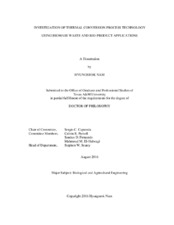| dc.description.abstract | The increasing demand for energy, the consequential depletion of fossil fuels, and the generation of waste materials has led to an interest in renewable and clean energy. In this work, thermochemical conversion processes of torrefaction, pyrolysis, and gasification were investigated to convert the agricultural and municipal wastes into three solid, liquid, and gas products. Also, the utilization of those products was studied to find the value added products.
Dairy manure was selected to be used as a thermochemical fuel source after removing the moisture content and sand content. The optimal initial manure condition was determined for developing a pilot-scale manure handling system. Also, a slagging and bed agglomeration prediction study indicated a low potential of ash. A fluidized bed gasification study using the processed dairy manure was performed, and the constructed empirical equations for syngas compositions were developed to predict the quality of syngas. A steam gasification was also conducted, and showed a higher H2 concentration compared to air gasification at the same operating condition. The CO2 gas removal from syngas was also successfully conducted.
Torrefaction with two wastes was conducted to observe the effects of temperatures and times on the yields and characteristics of products. The biomass waste processed at the highest temperature (290°C) was converted into a comparable fuel source, showing the highest heating value of 28.6 MJ/kg. A pyrolysis study using rice straw was conducted using auger, batch, and fluidized bed reactors to compare the product yields and their properties. The slow process resulted in higher yields of biochar (45 – 48 %), while the fast process produced a larger quantity of bio-oil (43%). The heating value of bio-oils from slow pyrolysis showed a relatively higher HHV than fast pyrolysis.
The pyrolysis products of bio-char and bio-oil were further studied. First, the biochar pyrolyzed was chemically activated. The highest surface area was determined as 1330 m^2 /g. Then, the adsorption and electrical performance of the activated carbon were evaluated. The activated carbon removed almost 95% of the pharmaceutical pollutants. The specific capacitance property of the carbon was obtained as 93 F/g. Last, nickel impregnated on the developed activated carbon was used to upgrade vacuum distilled microalgae pyrolytic bio-oil. | en |


